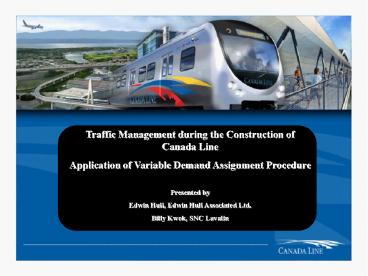Traffic Management during the Construction of Canada Line
1 / 30
Title: Traffic Management during the Construction of Canada Line
1
Traffic Management during the Construction of
Canada Line Application of Variable Demand
Assignment Procedure Presented by Edwin Hull,
Edwin Hull Associated Ltd. Billy Kwok, SNC Lavalin
2
(No Transcript)
3
(No Transcript)
4
EMME/2 Modelling
- Forecast volumes on affected roadways during
construction Estimate delays and increased
travel times Forecast volumes diverted to
alternative arterials Assess impacts of traffic
diverted to local streets Assess impacts on
transit operations - Develop measures of mitigation
5
Modelling Outputs Required
Reliable detailed intersection turning traffic
forecasts Reliable estimates of
delays Reliable forecast of traffic increase
on parallel arterials Reliable forecasts of
traffic on neighbourhood roads
6
Outputs Not Required
Long term demand forecasts Alternative
demographic inputs Transit Ridership Forecast
7
Model Development
Strategic Greater Vancouver Model
Unsuitable City of Vancouver Sub-regional
Unsuitable Need for Detailed Sub-area
Assignment models Downtown
Vancouver Cambie Street Corridor
No. 3 Road Corridor
8
Model Structure
Weekday AM and PM Peak Hour Auto
Assignment-Only Explicit Representation of
Intersection Laning And Signal Operations
Validated To Regional Screenline Counts Subarea
Intersection Counts Detailed Mesoscopic Inset
Within the Macroscopic Regional Model.
9
(No Transcript)
10
Synthesis of Signal Operations
- Turn Capacities Based on
- No of lanes
- Saturation Flow per lane
- Green time
- Cycle length
- Total traffic in shared lanes
- Opposing traffic volume (for permitted left
turns) - Pedestrian interference (right turns and some
left turns)
11
Synthesis of Signal Operations
- Capacity Green time / Cycle length Saturation
Flow Ped Factor - Saturation Flow
- 1800 veh/hour per lane for thru traffic movements
- 1600 veh/hour for turn lanes
- Ped Factor based on available pedestrian counts
12
Synthesis of Signal Operations
- Turn Delays Based on
- Cycle Length
- Green Time
- Volume/Capacity
13
Turn Delays
- Dedicated Lanes Protected Phases
- Base Delay ((Cycle length green time) 2) /
2 Cycle length - Congestion Delay (volume/capacity) 4
- fp50 (ep1 - ep2) 2 / (120 ep1) ((pvolau
pvolad) / ep3) 4 - Where
- ep1 cycle length (seconds)
- ep2 green time (seconds)
- ep3 capacity (vehicles per hour)
14
Shared Lanes
- Shared thru and right with no separate dedicated
thru lane - Shared thru and left with no separate dedicated
thru lane - Shared thru and right with a parallel dedicated
thru lane - Shared thru and left with a parallel dedicated
thru lane - Shared thru/right separate shared thru/left, no
other thru lane - Single approach lane for the thru movement and
both turns.
15
Shared thru/turn, no separate thru lane
- Initial capacity based on dedicated lane for each
movement - Capacity factored by share of previous assignment
volume
16
Shared thru/turn, separate thru lane
- Capacity for turn based on dedicated lane
- Thru capacity in shared lane factored by unused
turn capacity - Shared lane capacity added to thru capacity of
dedicated lanes
17
Two Shared Lanes, No Separate Thru Lane
- Capacity for turns based on dedicated lane
- Thru capacity in shared lane factored by unused
turn capacity - Thru capacity set at sum of net shared lane
capacity - If thru volume capacity, shared capacity
approach applied
18
Single Lane Approach
- Typically low volume intersections
- Local road intersects with major road
- Width of allows thru traffic to bypass left
turning vehicles - Treat as separate left turn lane and shared
thru/right lane.
19
Permitted Turns
- Two sneakers per Cycle
- Gaps in opposing through traffic flow
- Cp 0.25 Vot / Cot gp / c 1600 L 2
3600 / c - Cp capacity of permitted left turn phase
- Vot Opposing thru traffic volume
- Cot Opposing thru traffic capacity
- gp Green time for permitted left turn
- c cycle length
- L number of permitted lanes
20
Capacity Comparison
21
Capacity Comparison
22
Implementation
- Extra turn attributes
- _at_tncap turn capacity
- _at_lanes number of lanes and indication of lane
sharing - _at_green green time
- _at_cycle cycle length
- _at_sfact pedestrian factor
- _at_tfact capacity factor for shared lanes
- _at_nema approach direction code
- Temporary use of ui1, ui2, ui3, up1, up2, up3
23
Implementation
- For turns, _at_lanes number of (dedicated or
shared) lanes - Thru, _at_lanes dedicated thru lanes 0.25 for
shared thru/RT 0.5 for shared thru/LT - Capacity based on truncated integer value
- _at_lanes.mod.1 (0.25, 0.5 or 0.75) identifies
shared capacity calculation(s) required - Pedestrian factors (_at_sfact) based on pedestrian
counts and anecdotal evidence.
24
Direction Code
25
Dynamic Capacity Adjustment
- Iterative Procedure
- Gen cost Assignment (60-iterations) and capacity
adjustment - Six cycles of assignment and capacity adjustment
- Stable converged state
26
Base Demand Matrix Adjustment
- Initial matrices disaggregated from regional
model - Validated against the counts with demand
adjustment macro - Short Trips Constrained
- Constraints applied to preclude large cell values
27
Validation Results
28
Demand Suppression
- Driver Response to Capacity Reduction
- No change in behaviour.
- Change route.
- Carpool
- Change mode (transit, walk or bicycle)
- Change to a less congested time period.
- Change destination. (Other than work or
education) - Make no trip at all.
29
Variable Demand
Variable Demand Assignment of Base Matrix
fa1 mat1 (1.33 ( (mat2 - upqau) / (mat2
1))) Where mat1 Validated Based Demand
Matrix mat2 Based Network Generalised Cost
Matrix
30
Thank You!































